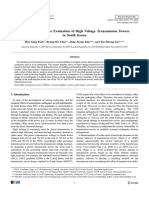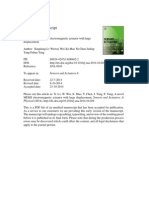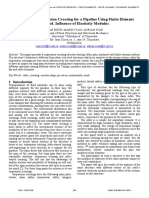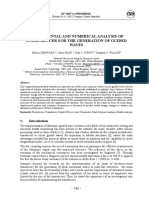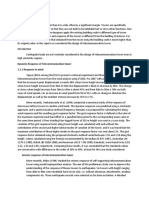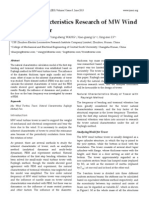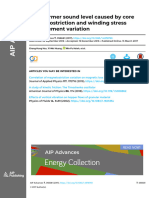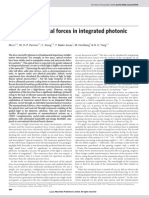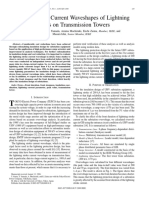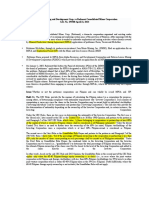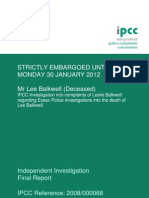Power Transmission
Power Transmission
Uploaded by
Xin Hui 杜新惠Copyright:
Available Formats
Power Transmission
Power Transmission
Uploaded by
Xin Hui 杜新惠Original Description:
Original Title
Copyright
Available Formats
Share this document
Did you find this document useful?
Is this content inappropriate?
Copyright:
Available Formats
Power Transmission
Power Transmission
Uploaded by
Xin Hui 杜新惠Copyright:
Available Formats
The 14
th
World Conference on Earthquake Engineering
October 12-17, 2008, Beijing, China
LONGITUDINAL RESPONSE OF POWER TRANSMISSION
TOWER-CABLE SYSTEM TO TRAVELING WAVE
Q.C. Liu
1
M.G. Yue
2
and D.S. Wang
3
1
China Communications Construction Company WuHan Harbour Engineering Design & Research Co.,Ltd,
Wuhan China
2
State Key Laboratory of Costal and Offshore Engineering, Dalian University of Technology, Dalian China
3
Institute of Road and Bridge Engineering, Dalian Maritime University, Dalian China
Email: ymg2008@126.com
ABSTRACT :
Based on the established model of power transmission tower-cable system, seismic response is analyzed with
time history method. Seismic response to traveling wave is compared with uniform wave, the results indicate
that: traveling wave excitation can increase, as well as decrease, the seismic response of power transmission
tower-cable system which depends on both traveling wave velocity and ground motion characteristics; traveling
wave excitations increase the cables axis force to a large extent, which will decrease gradually and approachto
the case of uniform excitations as velocity increasing; traveling wave strongly magnified cables displacement
response in longitudinal and vertical direction, especially the latter term under excitations of near-fault ground
motions; traveling wave velocity has great affection on the seismic response of power transmission tower-cable
system.
KEYWORDS:
power transmission tower-cable system; seismic response; traveling wave excitation;
uniform excitation; near-fault ground motions; traveling wave velocity
1. INTRODUCTION
High voltage power transmission line is the important component of power system, once it is destroyed, there
may be great economic losses and affections on society. Along with the economic development and the strategy
execution of power transmission from West to East, some power transmission towers have to be built in
intensive seismic zone. Although wind is the controlling load in present designation of power-transmit tower,
many transmission tower systems are still seriously destroyed in earthquake, such as Kobe earthquake in J apan
(Yin R.H. 2005) and Chi-Chi earthquake in Taiwan (1999). Because of particular dynamic characteristics and
seismic response of power transmission tower-cable system, many of them are destroyed seriously in
earthquake and result in great losses, so earthquake may be the controlling load in intensive seismic zone. For
large-span structures, excitation varies along the longitudinal axis of the wave propagation path in terms of
arrival time, amplitude and frequency content, a fact primarily attributed to the wave passage effect, the loss of
coherency and the effect of local site conditions (Ghobarah A., Lin J .H., Fan L.C., Zhang Y.H. and Zhao C.H.).
The spatial variability of ground motion has become significant for the seismic design of such structures. In
earthquake, wave propagation will also take place in the cable which has characteristics of small original stress,
large deflection and strong geometry nonlinearity (Li H.N. 1997). Large-scale movements of cable in vertical
direction will cause discharge or short circuit account for too small space between cables, even tensile failure
may be caused by large tension stress.
So, it is not sufficient only taking uniform excitation or single tower into consideration in seismic design. In this
paper, model of tower-cable system is established and wave propagation effect is taking into consideration in
nonlinear seismic response compared with uniform excitation.
2. FINITE ELEMENT MODEL AND EXCITATIONS
The 14
th
World Conference on Earthquake Engineering
October 12-17, 2008, Beijing, China
2.1 Finite Element Model (Yue M.G. 2005)
The model of tower-cable system is presented in Fig. 1. The towers height is 57m with span of 300m and with
4 layers cable. The top cable is ground wire with 2 GJ -80 wires and the 3 bottom layers cable is fire wire with 8
LGL-400 wires of each. The tower is modeled by beam element with 7 lumped masses in series. The cable is
modeled by truss element without compression bearing capacity, and the affection of original stress and
large-scale deflection are considered. The cable has 30 elements in each span and the vertical deflection is 5m
in span center. The tower bottom is encastred and the soil-structure interaction is neglected. The damping takes
3%. The main parameters of the model are listed in Table 1.
Table 1 Main parameters of tower-cable system
Number 1 2 3 4 5 6 7
Height (m) 0 12 23 30 38.5 47.17 57 Node
Mass (kg) / 14800 11760 12657 8632 6893 3084
Number 1 2 3 4 5 6 --
Sectional area (m
2
) 0.0497 0.0497 0.0363 0.0248 0.0150 0.0079 --
Moment of inertia (m
4
) 2.3172 1.0569 0.4548 0.2235 0.0869 0.0245 --
Element
Polar moment of inertia (m
4
) 3.6613 1.6689 0.7186 0.3531 0.1263 0.0345 --
Cable
Sectional area: 454.6mm
2
, Mass: 1626kg/km, Failure stress: 29kg/mm
2
, Youngs modulus:
800kg/mm
2
2.2 Earthquake Excitations
In this analysis, 8 recorded earthquake waves are used, 6 of which is near-fault record from Chi-chi earthquake
and the other 2 records are El Centro and Taft. All the near-fault records are component that perpendicular to
the fault (east-west direction). The peak ground acceleration is adjusted to 0.3g according to Code for seismic
design of buildings GB 50011-2001 (Chinese seismic code). The primary parameters of these records are listed in
Table 2.
Table 2 Parameters of records
Records PGA (g) PGV (cm/s) PGD (cm) Distance to fault (km) PGV/PGA (s)
TCU052 0.348 159.0 184.42 0.06 0.46
TCU054 0.148 59.4 59.42 5.92 0.40
TCU068 0.566 176.6 324.11 0.49 0.31
TCU075 0.333 88.3 86.45 1.49 0.27
TCU076 0.303 62.6 31.47 1.95 0.21
TCU102 0.298 112.4 89.19 1.79 0.38
El Centro 0.313 29.7 13.04 -- 94.89
Taft 0.178 17.5 8.84 -- 98.29
3. SEISMIC RESPONSE UNDER TRANVELING WAVE EXCITATIONS
Fig. 1 Finite Element Model of Power Transmission Tower-cable System
300m 300m 300m 300m 300m
5
7
1
2
3
4
5
6
7
1
2
3
4
5
6
m
The 14
th
World Conference on Earthquake Engineering
October 12-17, 2008, Beijing, China
3.1 Longitudinal Modals of Tower-Cable System
Modal analysis step, which takes the original stiffness consideration, must be carried out after static step under
gravity load. As the cable is very flexible element in the model, many micro-vibration modals appear in modal
analysis. In order to removing the affection of finite boundary, 10 principal modals of middle span in
longitudinal direction are extracted (Fig. 2). The dark lines are deformed shape and the light lines denote the
original model. In Fig. 2, the first 6 modes are mainly caused by wire vibration while the tower vibration is
involved in the last 4 modes. From the comparison of vibration periods of the systems 10 principal modals
with the first 6 periods of the single tower (Table 3), it is concluded that the systems periods are much larger
than the single tower because the cables vibration, and the towers fundamental period is increased from 0.39s
to 0.55s.
Table 3 Vibration periods (s)
Model 1 2 3 4 5 6 7 8 9 10
Tower-cable system 5.02 4.29 3.99 2.65 1.45 0.90 0.55 0.14 0.08 0.05
Single tower 0.39 0.15 0.08 0.05 0.04 0.03 -- -- -- --
3.2 Seismic Response of Tower
In order to study the affection of traveling wave, comparison of the systems seismic response is carried out
between uniform excitations and traveling wave excitations. Response ratio of the system (including moment
ratio, shear force ratio and drift ratio), which defined as ratio of response under traveling wave excitation to
response under uniform excitation, is presented in Fig. 3~Fig. 5, in which average value is for near-fault waves
and maximum value is for El Centro and Taft.
Traveling seismic wave excitation can increase, as well as decrease, the seismic response of the power transmission
tower-cable system which depends on both traveling-wave velocity and ground motion characteristic. When wave
Fig. 2 Ten modals of the tower-cable system in longitudinal direction
(g) Model 7, T=0.55s
(i) Model 9, T=0.08s (j) Model 10, T=0.05s
(d) Model 4, T=2.65s
(f) Model 6, T=0.90s
(h) Model 8, T=0.14s
(a) Model 1, T=5.02s (b) Model 2, T=4.29s
(c) Model 3, T=3.99s
(e) Model 5, T=1.45s
The 14
th
World Conference on Earthquake Engineering
October 12-17, 2008, Beijing, China
velocity is 300m/s, shear force of the tower at bottom increased 50% under excitations of El Centro and Taft which
represented far-field wave, and small increment also happened in moment at bottom and drift at top nodes. But for
near-fault waves, shear force raised about 4 times, and increment in moment at bottom is more than 1 times and drift
at top is slightly less than one times. So there are great differences in tower response for near-fault and far-fault field.
As the velocity increased to 600m/s or 900m/s, there are no much differences in tower response between near-fault
field and far-fault field, except for shear force at bottom and drift at lower joint. So, the towers seismic response will
decrease with wave velocity increasing. As to 1200m/s, towers response to traveling wave excitation is less than
which to uniform excitation on the whole. Shear force and moment at bottom will reduce to 50% for El Centro and
Taft, and drift at top will reduce to about 40%. The corresponding terms for near-fault waves is 80% and 50%
respectively. So, towers response for near-fault wave is higher than which for El Centro and Taft at higher velocity.
For uniform excitation, seismic response ratio of tower under near-fault wave is close to which under El Centro
and Taft wave (Yue M.G. 2005). While for traveling wave excitation, seismic response of tower may be
depended on wave velocity to a certain extent. When velocity is low (300m/s for example), near-fault wave can
enhance towers response intensively. As a whole, when velocity varies from 300m/s to 1200m/s, the range of
variation in tower response ratio is about 50 for El Centro and Taft, and the range is more wider for
near-fault wave.
Considering the uniform excitation is equivalent to infinite velocity of traveling wave, seismic response of
tower to El Centro and Taft is also calculated for velocity of 3000m/s, 6000m/s and 15000m/s. In order to
saving paper length, only moment ratio of tower is presented in Table 4. The moment ratio approaches to 1.0,
especially for Taft. As a result, the model is approved to be rational.
Fig.3 Distribution of tower shear force ratio
1
2
3
4
5
6
0 1 2 3 4 5
Taft
El Centro
Near-Fault
Shear Force Ratio (900m/s)
1
2
3
4
5
6
0 1 2 3 4 5
Taft
El Centro
Near-Fault
Shear Force Ratio (1200m/s)
1
2
3
4
5
6
0 1 2 3 4 5
E
l
e
m
e
n
t
N
u
m
b
e
r
Taft
El Centro
Near-Fault
Shear Froce Ratio (300m/s)
1
2
3
4
5
6
0 1 2 3 4 5
Taft
El Centro
Near-Fault
Shear Force Ratio (600m/s)
1
2
3
4
5
6
0.5 1.0 1.5 2.0 2.5
E
l
e
m
e
n
t
N
u
m
b
e
r
Taft
EL Centro
Near-Fault
Moment Ratio (300m/s)
1
2
3
4
5
6
0.5 1.0 1.5 2.0 2.5
Taft
EL Centro
Near-Fault
Moment Ratio(600m/s)
1
2
3
4
5
6
0.0 0.5 1.0 1.5 2.0 2.5
Moment Ratio(900m/s)
Taft
EL Centro
Near-Fault
1
2
3
4
5
6
0.0 0.5 1.0 1.5 2.0 2.5
Taft
EL Centro
Near-Fault
Moment Ratio(1200m/s)
Fig. 4 Distribution of tower moment ratio
Fig. 5 Distribution of tower drift ratio
2
3
4
5
6
7
0.5 1.0 1.5 2.0 2.5 3.0
N
o
d
e
N
u
m
b
e
r
Taft
El Centro
Near-Fault
Drift Ratio(300m/s)
2
3
4
5
6
7
0.0 0.5 1.0 1.5 2.0 2.5 3.0
Taft
El Centro
Near-Fault
Drift Ratio (600m/s)
2
3
4
5
6
7
0.0 0.5 1.0 1.5 2.0 2.5 3.0
DriftRatio(900m/s)
Taft
El Centro
Near-Fault
2
3
4
5
6
7
0.0 0.5 1.0 1.5 2.0 2.5 3.0
Drift Ratio(1200m/s)
Taft
El Centro
Near-Fault
The 14
th
World Conference on Earthquake Engineering
October 12-17, 2008, Beijing, China
Table 4 Moment ratio of tower for different wave velocities
3000m/s 6000m/s 15000m/s
Node Number
El Centro Taft El Centro Taft El Centro Taft
7 \ \ \ \ \ \
6 0.75 1.09 0.90 1.07 0.97 1.00
5 0.48 1.02 0.81 1.02 1.06 1.02
4 0.44 1.00 0.78 0.98 1.15 1.00
3 0.48 1.03 0.80 0.97 1.20 1.03
2 0.54 1.08 0.80 0.98 1.23 1.08
1 0.59 1.12 0.81 0.99 1.24 1.12
3.3 Axial Force of Cable
Seismic response of cable is also analyzed under traveling wave excitation, and comparison with uniform
excitation is also presented. Axial force of cable to near-fault wave is nearly the same all through cable length,
so we can conclude that axial force is uniformly distributed along cable. In order to illuminate affection of
traveling wave on cables axial force, axial force ratio of traveling wave excitation to uniformexcitation is
studied and axial force ratio at span end is given as example (Fig. 6). Average value is for near-fault waves and
maximum value is for El Centro and Taft.
The above Figure indicates that axial force of cable is increased by traveling wave to a large extent. Especially
for near-fault wave, increment in cable axial force is more than one times when wave velocity is low
(300m/s~600m/s), the corresponding increment is about 25%~50% for El Centro and Taft. The increment in
cables axial force under traveling wave excitation becomes slow as wave velocity increasing, and cable
response will approach to uniform excitation for infinite velocity.
3.4 Displacement of Cable
Seismic displacement of cable is also compared between traveling wave and uniform wave. Only longitudinal
displacement of cable at 1/4 span and vertical displacement of cable at span center are given in Table 5 and
Table 6 respectively, more details see reference (Yue M.G. 2005).
Longitudinal displacement of upper layer cable is a bit larger than the lower layer for traveling wave, and so is
it for uniform wave. Under uniform excitation, cables longitudinal displacement is nearly uniformly distributed
along cable length. But for traveling wave, longitudinal displacement at 1/4(3/4) span is larger than span center.
The trend of cables longitudinal displacement is similar to cables axial force, that is: cables longitudinal
response is intensively magnified by traveling wave, especially for near-fault wave at lower velocity,
displacement reaches to 27~35cm for top layer cable and 19~30cm for bottom layer cable at 1/4 span, and the
corresponding term for uniform wave is only 11cm and 3cm. The cables response under traveling wave
excitation approaches to uniform wave excitation as wave velocity increasing.
4
3
2
1
1.0 1.5 2.0 2.5 3.0
W
i
r
e
L
a
y
e
r
(
T
o
p
t
o
B
o
t
t
o
m
)
Near-Fault
Taft
El Centro
Axial forceRatio(300m/s)
4
3
2
1
1.0 1.5 2.0 2.5 3.0
Axial Force Ratio (600m/s)
Near-Fault
Taft
El Centro
4
3
2
1
1.0 1.5 2.0 2.5 3.0
Near-Fault
Taft
El Centro
Axial ForceRatio (900m/s)
4
3
2
1
1.0 1.5 2.0 2.5 3.0
Near-Fault
Taft
El Centro
Axial ForceRatio(1200m/s)
Fig. 6 Axial force ratio of cable
The 14
th
World Conference on Earthquake Engineering
October 12-17, 2008, Beijing, China
Table 5 Longitudinal displacement of cable at 1/4 span (cm)
Traveling Wave
Wave
Layer
Number
300m/s 600m/s 900m/s 1200m/s
Uniform
Wave
1 35.1 27.1 15.8 11.3 11.0
2 30.9 21.8 14.0 10.2 7.1
3 30.4 20.1 13.0 9.6 4.3
Near-Fault
4 30.1 19.0 12.4 9.3 2.5
1 14.3 17.6 9.8 8.5 13.0
2 13.6 13.8 8.3 7.3 8.4
3 13.1 11.0 7.3 6.7 5.1
El Centro
4 12.8 9.1 6.9 6.8 3.0
1 11.4 12.8 12.5 8.3 9.0
2 10.1 10.4 9.8 7.2 5.7
3 10.0 9.3 7.8 6.4 3.7
Taft
4 10.3 8.4 7.2 6.1 2.1
Annotation: The layer numbering is from top to bottom.
Table 6 Vertical displacement of cable at span center (cm)
Traveling Wave
Wave
Layer
Number 300m/s 600m/s 900m/s 1200m/s
Uniform
Wave
1 493.1 326.0 194.7 157.1 0.8
2 525.9 341.1 195.2 158.0 0.3
3 561.2 357.3 195.7 158.6 0.2
Near-Fault
4 594.3 372.3 196.3 159.1 0.2
1 53.5 33.9 24.2 18.6 0.5
2 56.8 34.8 24.4 18.6 0.2
3 61.6 35.6 24.5 18.6 0.1
El Centro
4 65.8 36.3 24.7 18.6 0.1
1 115.7 63.0 43.4 32.7 0.4
2 115.3 63.3 43.1 32.5 0.1
3 117.5 63.6 43.0 32.2 0.1
Taft
4 120.7 63.9 42.8 32.1 0.1
Annotation: The layer numbering is from top to bottom.
Vertical displacement of cable at bottom layer is larger than which at top layer for traveling wave, while it is
opposite for uniform wave. Cables seismic responseat vertical direction to traveling wave is much higher than
which to uniform wave, and response at span center is more intensive than which at 1/4(3/4) span obviously.
Take velocity of 1200m/s, smallest vertical response, as example, vertical displacement is 158cm at span center
and 105cm at 1/4 span for traveling wave, and average value for El Centro and Taft is 25cm at span center and
20cm at 1/4 span. So, vertical displacement of cable for traveling wave is 5 or 6 times higher than that for
uniform wave. Under uniform excitation, cables vertical displacement is no more than 1cm at span center and
7cm at 1/4 span for all the input waves. When velocity is 300m/s, cables upward displacement can reach to
5m~7m for traveling near-fault wave, nearly equal to deflection of cable under gravity.
The 14
th
World Conference on Earthquake Engineering
October 12-17, 2008, Beijing, China
4. CONCLUSION
By the user of finite element model of power transmission tower-cable system, seismic response of tower and
cable is analyzed account for traveling wave and uniform wave excitation. We can conclude:
1) Comparing uniform wave, traveling wave can increase, as well as decrease, seismic response of power
transmission tower-cable system which depends on both traveling-wave velocity and ground motion characteristic.
When velocity is low, seismic response of tower is magnified by traveling wave to a certain extent, which is
disadvantage for lower portion of tower.
2) Cables axial force is increased by traveling wave to a large extent especially for near-fault wave. Axial force
can increase more than one times at lower velocity (300m/s~600m/s), and which will approach to uniform
excitation as velocity increasing.
3) Cables displacement response is intensively magnified by traveling wave, especially for near-fault wave,
vertical displacement can reach to 5m~7m.
4) Wave velocity has a great affection on seismic response of power transmission tower-cable system, so it is
very important to assure the wave velocity in practical.
Only traveling wave effect is considered in this paper, further more studies on coherent effect and local site
effect are still needed.
ACKNOWLEGMENTS
Thanks for the support of National Natural Science Foundation of China (59978025) and Key Seismic Technique
Research and Demonstration of Large and Important Buildings, Sub-topics of Eleventh Five-Year National
Scientific Support Plan (No. 20070106110141014).
REFERENCES
Yin Ronghua, Li Dongliang and Liu Gelin etc. Seismic damage and analysis of power transmission towers.
World Earthquake Engineering, 2005, 21: 1, 51-54 (in Chinese)
National Center for Research on Earthquake Engineering in Taiwan, Disaster investigation report of 921 Chi-Chi
earthquake. Taipei, 2001
A. Ghobarah, T.S. Aziz and M. El-Attar. Response of Transmission Lines to Multiple Support Excitations.
Engineering Structures. 1996, 18: 12, 936946
Lin J iahao, Zhong Wanxie and Zhang Yahui. Seismic analysis of long span structures by means of random
vibration approach]. Journal of Building Structures, 2000, 21: 1, 29-36 (in Chinese)
Fan Lichu, Wang J unjie and Chen Wei. Response characteristics of long-span cable-stayed bridges under
non-uniform seismic action. Chinese Journal of Computational Mechanics, 2001, 18: 3, 358-63 (in Chinese)
Zhang Yahui, Li Liyuan and Chen Yan etc. Wave passage effect on random seismic response of long-span
structures. Journal of Dalian University of Technology, 2005, 45: 4, 480-6 (in Chinese)
Zhao Canhui. The Asynchronous excitation model for the seismic response analysis of long-span bridges.
Journal of Southwest Jiaotong University, 200237: 3, 236-40 (in Chinese)
Li Hongnan and Wang Qianxin. Dynamic characteristics of long-span transmission lines and their supporting
towers. China Civil Engineering Journal, 1997, 30: 5, 28-36
Yue Maoguang, Wang Dongsheng and Li Hongnan etc. Response of power transmission tower-cable system
subjected to near-fault ground motions. Earthquake Engineering and Engineering Vibration, 2005, 25: 4,
116-25 (in Chinese)
Yue Maoguang, Wang Dongsheng and Li Hongnan etc. Cables seismic response of the tower transmission
tower-cable system. 14
th
Structure Engineering Conference of China, third volume, 2005, 175-80 (in Chinese)
You might also like
- Study of a reluctance magnetic gearbox for energy storage system applicationFrom EverandStudy of a reluctance magnetic gearbox for energy storage system applicationRating: 1 out of 5 stars1/5 (1)
- It Is Quite Another Electricity: Transmitting by One Wire and Without GroundingFrom EverandIt Is Quite Another Electricity: Transmitting by One Wire and Without GroundingRating: 4.5 out of 5 stars4.5/5 (2)
- Analysis of Tower Footing Resistance Effected Back Flashover Across Insulator in A Transmission SystemDocument6 pagesAnalysis of Tower Footing Resistance Effected Back Flashover Across Insulator in A Transmission SystemUdomkarn Smt100% (1)
- Study of Tower Grounding Resistance Effected Back Flashover To 500 KV Transmission Line in Thailand by Using ATP/EMTPDocument8 pagesStudy of Tower Grounding Resistance Effected Back Flashover To 500 KV Transmission Line in Thailand by Using ATP/EMTPzerferuzNo ratings yet
- Progressive Collapse Analysis of Power Transmission TowerDocument6 pagesProgressive Collapse Analysis of Power Transmission TowerAnand KesarkarNo ratings yet
- 2015 - Seismic Performance Evaluation of High Voltage Transmission TowersDocument7 pages2015 - Seismic Performance Evaluation of High Voltage Transmission Towers2019410007No ratings yet
- Collapse Analysis of A Transmission Tower Under Wind ExcitationDocument7 pagesCollapse Analysis of A Transmission Tower Under Wind ExcitationRm1262100% (1)
- 2006 - N Murota - Earthquakesimulatortestingofbaseisolatedpowertrans (Retrieved 2016-11-23)Document9 pages2006 - N Murota - Earthquakesimulatortestingofbaseisolatedpowertrans (Retrieved 2016-11-23)emilioaraNo ratings yet
- Tugas Review Paper 1 IntanDocument7 pagesTugas Review Paper 1 IntanntunNo ratings yet
- Nla Tall Building Near Fault PDFDocument25 pagesNla Tall Building Near Fault PDFsabareesan09No ratings yet
- Seismic LoadingDocument21 pagesSeismic LoadingJovana BožovićNo ratings yet
- Behaviour of Off-Shore Structures: Proceedings of The Third International ConferenceDocument17 pagesBehaviour of Off-Shore Structures: Proceedings of The Third International ConferenceKatherine FoxNo ratings yet
- Pipe Supp Seismic IITKDocument7 pagesPipe Supp Seismic IITKPGHOSH11No ratings yet
- Characterization of Metallic-Particle Dynamics in Compressed SF - Insulated Systems Under Different Voltage StressesDocument6 pagesCharacterization of Metallic-Particle Dynamics in Compressed SF - Insulated Systems Under Different Voltage StressesItalo ChiarellaNo ratings yet
- Nonlinear Dynamic Response of A Tall Building To Near Fault Pulse-Like Ground MotionsDocument25 pagesNonlinear Dynamic Response of A Tall Building To Near Fault Pulse-Like Ground MotionsjustinhehanuaNo ratings yet
- Young Researcher MeetingDocument1 pageYoung Researcher MeetingNhật Nam NguyễnNo ratings yet
- Accepted Manuscript: Sensors and Actuators ADocument22 pagesAccepted Manuscript: Sensors and Actuators AParvulescu CatalinNo ratings yet
- Response Analysis of A Transmission Tower-Line System To Spatial Ground MotionsDocument9 pagesResponse Analysis of A Transmission Tower-Line System To Spatial Ground MotionsLae OerdiNo ratings yet
- Ipst PDFDocument6 pagesIpst PDFalexanderlimaNo ratings yet
- Dynamic Load Factors 5Document14 pagesDynamic Load Factors 5Solomon MiNo ratings yet
- Analysis of Lightning Surge Phenomenon and Surge Arrester Performance of A 400kV Transmission SystemDocument10 pagesAnalysis of Lightning Surge Phenomenon and Surge Arrester Performance of A 400kV Transmission SystemVigneshwaran KandaswamyNo ratings yet
- FB 40 PDFDocument4 pagesFB 40 PDFOscar ChappilliquénNo ratings yet
- Microelectromechanical Systems Vibration Powered Electromagnetic Generator For Wireless Sensor ApplicationsDocument7 pagesMicroelectromechanical Systems Vibration Powered Electromagnetic Generator For Wireless Sensor ApplicationskhodabandelouNo ratings yet
- Modeling Guidelines For Fast Front TransientsDocument14 pagesModeling Guidelines For Fast Front TransientsMagdiel SchmitzNo ratings yet
- Simplified Seismic Analysis of TowersDocument4 pagesSimplified Seismic Analysis of TowersramNo ratings yet
- Akashi Kaikyo Bridge 1Document29 pagesAkashi Kaikyo Bridge 1Ssiddhartha VemuriNo ratings yet
- Experimental and Numerical Analysis of A Transducer For The Generation of Guided WavesDocument9 pagesExperimental and Numerical Analysis of A Transducer For The Generation of Guided Wavesdavood abbasiNo ratings yet
- New QBhve3yearDocument29 pagesNew QBhve3yearArun SelvarajNo ratings yet
- Backflashover Analysis For 110-kV Lines at Multi-Circuit Overhead Line TowersDocument6 pagesBackflashover Analysis For 110-kV Lines at Multi-Circuit Overhead Line TowersboopelectraNo ratings yet
- End-Winding Vibrations Caused by Steady-State Magnetic ForcesDocument10 pagesEnd-Winding Vibrations Caused by Steady-State Magnetic ForcesandikaubhNo ratings yet
- Field Tests of Grounding at An Actual Wind Turbine Generator SystemDocument6 pagesField Tests of Grounding at An Actual Wind Turbine Generator Systembal3xNo ratings yet
- Analysis of Wind Stability of Cable-Stayed Bridge With Single Cable PlaneDocument3 pagesAnalysis of Wind Stability of Cable-Stayed Bridge With Single Cable PlanebulbucataNo ratings yet
- Lightning Simulation Study On Line Insulators (Surge Arresters) (110kV Overhead Power Line "Fierze F. Arrez - HC Dardhe")Document8 pagesLightning Simulation Study On Line Insulators (Surge Arresters) (110kV Overhead Power Line "Fierze F. Arrez - HC Dardhe")ZeroMetkaNo ratings yet
- Dynamic Response of Telecommunication Tower 1.2.1 Response To WindDocument6 pagesDynamic Response of Telecommunication Tower 1.2.1 Response To Windjerico habitanNo ratings yet
- Pesgm2006 000102Document6 pagesPesgm2006 000102sunitharajababuNo ratings yet
- Steel Lattice Telecommunication MastsDocument7 pagesSteel Lattice Telecommunication MastsjojogarciaNo ratings yet
- Electromagnetic Field Radiation Model For Lightning Stro To Tall StructuresDocument9 pagesElectromagnetic Field Radiation Model For Lightning Stro To Tall StructuresToky Fanambinana RanaivoarisoaNo ratings yet
- Ijciet: International Journal of Civil Engineering and Technology (Ijciet)Document9 pagesIjciet: International Journal of Civil Engineering and Technology (Ijciet)IAEME PublicationNo ratings yet
- Natural Characteristics Research of MW Wind Turbine TowerDocument5 pagesNatural Characteristics Research of MW Wind Turbine TowerSEP-PublisherNo ratings yet
- Influence of Lightning Flashover Criterion On The Calculated Lightning Withstand Level of 800 KV UHVDC Transmission Lines at High AltitudeDocument7 pagesInfluence of Lightning Flashover Criterion On The Calculated Lightning Withstand Level of 800 KV UHVDC Transmission Lines at High Altitudeqais652002No ratings yet
- Transformer Sound Level 01Document8 pagesTransformer Sound Level 01Kukuh MRNo ratings yet
- Letters: Harnessing Optical Forces in Integrated Photonic CircuitsDocument6 pagesLetters: Harnessing Optical Forces in Integrated Photonic CircuitsSabiran GibranNo ratings yet
- Finite Element Seismic Analysis of A Guyed MastDocument15 pagesFinite Element Seismic Analysis of A Guyed MastsebaingNo ratings yet
- 2 Marks With Answer 16 Mark QuestionsDocument45 pages2 Marks With Answer 16 Mark QuestionsSenthil IlangovanNo ratings yet
- Effects of Fracture Material Properties On Crack Propagation of Concrete Gravity Dams During Large EarthquakesDocument13 pagesEffects of Fracture Material Properties On Crack Propagation of Concrete Gravity Dams During Large EarthquakesShantanu ManeNo ratings yet
- Design of Large Scale Wind Turbine Towers in Seismic Areas: Iakovos LavassasDocument8 pagesDesign of Large Scale Wind Turbine Towers in Seismic Areas: Iakovos LavassasYadava JaffaNo ratings yet
- Dr. M.A. Mueller, Dr. J.R. Bumby and Prof. E. SpoonerDocument6 pagesDr. M.A. Mueller, Dr. J.R. Bumby and Prof. E. SpoonernakllkNo ratings yet
- Energy HarvestorDocument9 pagesEnergy HarvestorashishNo ratings yet
- Zheng 2015Document20 pagesZheng 2015naqash tahirNo ratings yet
- Narita Et Al. - 2000 - Observation of Current Waveshapes of Lightning STRDocument7 pagesNarita Et Al. - 2000 - Observation of Current Waveshapes of Lightning STRToky Fanambinana RanaivoarisoaNo ratings yet
- Omae2009 79793 2 PDFDocument10 pagesOmae2009 79793 2 PDFJohn AshlinNo ratings yet
- Tangential DriveDocument5 pagesTangential Drivecopkutusu2012No ratings yet
- 2-Multi-Circuit Tower PDFDocument6 pages2-Multi-Circuit Tower PDFVishalNo ratings yet
- Application of The Antenna Theory Model To A Tall Tower Struck by LightningDocument9 pagesApplication of The Antenna Theory Model To A Tall Tower Struck by LightningToky Fanambinana RanaivoarisoaNo ratings yet
- 2018 Direct Observation of The Domain Kinetics During Polarization Reversal of Tetragonal PMN PTDocument6 pages2018 Direct Observation of The Domain Kinetics During Polarization Reversal of Tetragonal PMN PTAnaghaNo ratings yet
- Simplified Approach To Calculate The Back Flashover Voltage of Shielded H.V. Transmission Line TowersDocument5 pagesSimplified Approach To Calculate The Back Flashover Voltage of Shielded H.V. Transmission Line TowerszerferuzNo ratings yet
- Mechanical Forces and Magnetic Field Simulation of Transformer With Finite Element MethodDocument4 pagesMechanical Forces and Magnetic Field Simulation of Transformer With Finite Element MethodSarojakanti SahooNo ratings yet
- Vacuum Nanoelectronic Devices: Novel Electron Sources and ApplicationsFrom EverandVacuum Nanoelectronic Devices: Novel Electron Sources and ApplicationsNo ratings yet
- Questions: Comma PlacementDocument8 pagesQuestions: Comma PlacementZarbibi Hussain khelNo ratings yet
- Virtual Reality in Tourism A State-Of-Theart PDFDocument28 pagesVirtual Reality in Tourism A State-Of-Theart PDFyatendra1singhNo ratings yet
- DRILLLSSSDocument2 pagesDRILLLSSSdeanyangg25No ratings yet
- Thai Recycled Costume EssayDocument5 pagesThai Recycled Costume Essayapi-381916670No ratings yet
- GRADE 9 MAPEH 1st Monthly ExaminationDocument2 pagesGRADE 9 MAPEH 1st Monthly ExaminationHoward AranetaNo ratings yet
- in Language That Becomes ExtinctDocument4 pagesin Language That Becomes ExtinctQuân Lê ĐàoNo ratings yet
- Own DigestDocument16 pagesOwn Digestellyn suwalawanNo ratings yet
- The Role of Advocacy and Professional NursingDocument12 pagesThe Role of Advocacy and Professional Nursingbgrubbs678No ratings yet
- Holiday Themed Ratios and Proportions: Task Cards With QR Codes!Document5 pagesHoliday Themed Ratios and Proportions: Task Cards With QR Codes!api-531331330No ratings yet
- Service Manager 932 Support MatrixDocument24 pagesService Manager 932 Support MatrixGeorge AnadranistakisNo ratings yet
- The Official Logo of The Synodal PathDocument7 pagesThe Official Logo of The Synodal PathMary Ann SantosNo ratings yet
- Les Balkwell Final Report Published With Foreword Feb 1Document147 pagesLes Balkwell Final Report Published With Foreword Feb 1Bren RyanNo ratings yet
- Human Person Towards Impending Death StudentsDocument23 pagesHuman Person Towards Impending Death StudentsAnnXNo ratings yet
- SPM Bio 2011 k1Document42 pagesSPM Bio 2011 k1khangsiean89No ratings yet
- Finite Automata With Output: Ege University Department of Computer EngineeringDocument14 pagesFinite Automata With Output: Ege University Department of Computer Engineeringvuslat88No ratings yet
- I Am Sharing DNA Imprint Recognition Device PPT With You 2Document17 pagesI Am Sharing DNA Imprint Recognition Device PPT With You 2lj emademNo ratings yet
- David T. Runia-Studia Philonica Annual - Studies in Hellenistic Judaism, Vol. XVII, 2005 (Brown Judaic Studies 344) (2005) PDFDocument273 pagesDavid T. Runia-Studia Philonica Annual - Studies in Hellenistic Judaism, Vol. XVII, 2005 (Brown Judaic Studies 344) (2005) PDFBurdet Onita100% (1)
- The Debated Mind Evolutionary Psychology Versus EthnographyDocument238 pagesThe Debated Mind Evolutionary Psychology Versus EthnographyMarlene TavaresNo ratings yet
- Chapter 65 (Introduction To Viruses)Document16 pagesChapter 65 (Introduction To Viruses)leoNo ratings yet
- Age of SensibilityDocument2 pagesAge of SensibilitySulfa RaisNo ratings yet
- 2020-04-06 Upstream Addicks - Doc 280 United States' RESPONSE To 279 CROSS MOTION and RESPONSE To 276 Motion To Clarify Scope of EasementDocument10 pages2020-04-06 Upstream Addicks - Doc 280 United States' RESPONSE To 279 CROSS MOTION and RESPONSE To 276 Motion To Clarify Scope of EasementDaniel CharestNo ratings yet
- Lesson Plan On Probability and StatisticsDocument2 pagesLesson Plan On Probability and StatisticsRam AndresNo ratings yet
- DfmeaDocument13 pagesDfmeaAshisNo ratings yet
- Teknik Pencarian Literatur Dan Analisis Jurnal KeperawatanDocument30 pagesTeknik Pencarian Literatur Dan Analisis Jurnal Keperawatanmademerlin92100% (1)
- Bi Lobar Post Auricular Skin Flap For Reconstruction of The EarlobeDocument3 pagesBi Lobar Post Auricular Skin Flap For Reconstruction of The Earlobedrgurpal74No ratings yet
- PracRes Additional Notes 2Document11 pagesPracRes Additional Notes 2EllyNo ratings yet
- Abstract Algebra VocabularyDocument4 pagesAbstract Algebra VocabularyDefault0No ratings yet
- Ascano v. JacintoDocument1 pageAscano v. JacintoEmmanuel YrreverreNo ratings yet
- Bio FiberDocument2 pagesBio FiberGelina HernandezNo ratings yet





